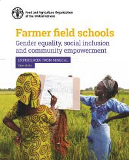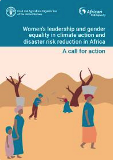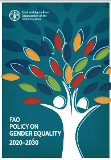In the face of escalating global challenges, sustainable plant production and protection stand as a beacon of hope for the future of our planet. From climate change to diminishing natural resources, the agricultural sector must adopt an innovative and inclusive approach to ensure food security and environmental sustainability.
Recognizing the critical role of gender equality in this equation is essential for fostering resilient and productive agrifood systems: empowering both genders equally fosters innovation, improves resilience and promotes sustainable practices. Advancing gender equality in plant production and protection isn't just fair—it's a strategic necessity for productive, sustainable agriculture.”
Stories
News

Enhancing FAO projects through gender perspectives
10/07/2024
Recognizing the importance of staff learning, the FAO Plant Production and Protection division and the Rural Transformation and Gender Equality Division jointly organized a training on “Mainstreaming Gender in Plant Production and Protection Projects”.

Cultivating seeds of wisdom in Zimbabwe
08/07/2024
In Gokwe, in northern Zimbabwe, farmers have been instrumental in shaping nature positive and agroecological practices for generations. Through their dedication and innovative approaches, women farmers have not only preserved biodiversity but also promoted sustainable farming techniques over time.

Strengthening women’s voices through collective organizations in India
01/07/2024
In India, women play a pivotal role in driving change in the agriculture sector. In the second of three videos on "Women and Agroecology," we look at how women’s organizations cultivate collaboration.

Empowering female farmers in crop production systems
08/03/2024
FAO recognizes women’s need to access agricultural mechanization in plant production to conduct their farming practices profitably and efficiently. Sustainable agricultural mechanization covers all levels of farming and processing technologies, from simple and basic hand tools to more sophisticated and motorized equipment.
Publications

The unjust climate: Measuring the impacts of climate change on rural poor, women and youth
2024
Developing policies to foster inclusive rural transformation processes requires better evidence on how climate change is affecting the livelihoods and economic behaviours of vulnerable rural people, including women, youths and people living in poverty.

Women leading mechanization hire services: An inspiring story from Chiti village, Nepal
2023
Nepal, a landlocked country known for its mountain peaks including Mount Everest — the world’s tallest peak, is home to Chiti village. Most households of Chiti village rely on agriculture and wage labour for their livelihoods.

Sustainable mechanization as a means to empower women processors in Benin
2023
This flyer presents the gender responsive approach to mechanization piloted in Benin. In 2020, the government of Benin developed the National Strategy for Agricultural Mechanization (SNMA) – with FAO’s financial and technical assistance – presenting a clear vision and priorities for agricultural mechanization.

Farmer field schools, gender equality, social inclusion and community empowerment
2023
Senegal has had extensive experience with the development and implementation of the farmer field school (FFS) approach across almost two decades.

The Status of Women in Agrofood Systems
2023
The Status of Women in Agrifood Systems report provides the latest data, lessons learned and recommendations for policy and decision makers about gender in agrifood systems.

Empowering women farmers - A mechanization catalogue for practitioners
2022
Rural women across the world work along agri-food value chains performing numerous agricultural operations. Their work is increasingly affected by land degradation, climate change impacts, and out-migration. It is often unrecognized, unqualified, and unpaid.

Women farmers’ access to sustainable agricultural mechanization
2022
With the massive out-migration of men from the villages, women’s work has increased at both household and farm levels. Women thus face additional work burdens and challenges in securing their households’ food security and livelihoods.

Addressing gender issues in pesticide management
2022
The Rotterdam Convention Secretariat (NSPRD) and the Gender team in ESP developed this publication with the objective of highlighting the gender-related implication of pesticide use and management, focusing on the role of women in handling hazardous pesticides in agriculture, the reasons why they are at higher risk and the health-related implications they face.

Women's leadership and gender equality in climate action and disaster risk reduction in Africa
2021
Despite the key roles that rural women play in food systems, in agrobiodiversity conservation, natural resource management, food production, preparation and marketing, rural women are particularly affected by the impacts of climate change due to limited access and control over resources fundamental to adaptation and limited participation in decision-making processes.

Indigenous women, daughters of Mother Earth
2020
There are 476 million indigenous peoples around the world, constituting 6.2 percent of the global population and, according to different sources, representing more than 19% of the extreme poor (ILO, 2019) of the world. Half of this population are women (approximately 240 million).

FAO Policy on Gender Equality 2020 - 2030
2020
Gender equality is essential to achieve FAO’s mandate of a world free from hunger, malnutrition and poverty. The Organization recognizes that persisting inequalities between women and men are a major obstacle to agriculture and rural development

